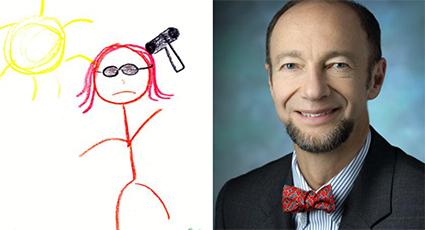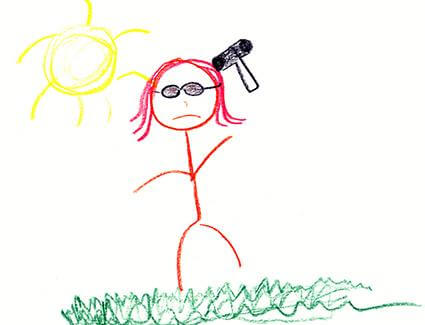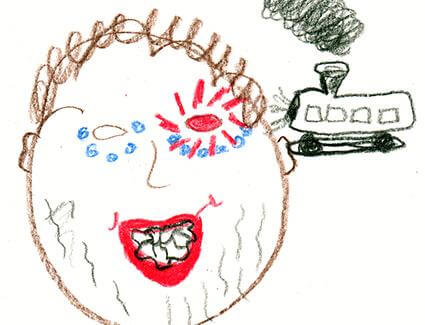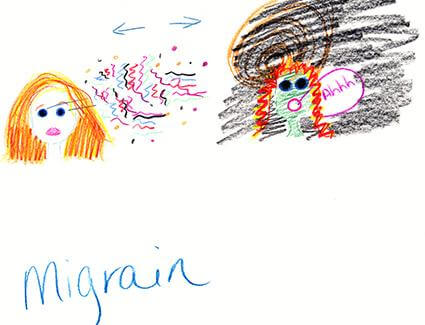
The incidence of headaches among young children is not insignificant—2.5 percent of children 7 years of age and under and 5 percent of 7-to-15 year olds in this country suffer migraines. Also, many more of the afflicted may be missed because accurate diagnosis is tricky. There’s no blood test or imaging scan that will delineate a headache or distinguish migraine from non-migraine pain. Physical examination may reveal some important diagnostic information, like a headache related to otitis media, but exam alone is not conclusive. And the key to appropriate treatment, of course, is an accurate diagnosis.
“Headache is diagnosed clinically by a detailed history,” pediatric neurologist Carl Stafstrom, above, said at a recent Johns Hopkins Children’s Center Grand Rounds. “No lab test or imaging modality can substitute for a detailed clinical history.”
But what if the young patient is unable to verbally describe his or her headache—migraine symptoms like unilateral throbbing and visual auras and non-migraine headache features like band-like pain and tension on the side or back of the neck? Further complicating matters, Stafstrom noted, the International Headache Society’s criteria for adult migraine require 5 attacks lasting 2 to 72 hours, nausea or vomiting, and sensitivity to light or sound—criteria that don’t necessarily fit migraines in children. Headaches, he stressed, can manifest differently at different ages.
“Migraines in children are often much shorter, they are frequently bilateral, and kids don’t get auras as commonly as adults, although they do have GI symptoms like nausea more often,” said Stafstrom. “Also, migraine variants such as benign paroxysmal vertigo and cyclic vomiting are very common in children.”
So, to flesh out such symptoms in his less verbally sophisticated young patients, Stafstrom enlisted their expressive and artistic talents to assist in diagnosis. He asked his patients to first explain their headaches in words and also asked them to draw a picture of how they see the pain in their head: “What does your headache feel like? Show me in a drawing.”
When hearing this request, initially, some patients think Stafstrom is, in his own words, “off his rocker,” but eventually almost all children comply, #2 pencils in hand. What do the resulting renderings show?
In one drawing red spots around the eyes indicate the patient’s pain, another depicts a horse kicking the side of the patient’s head, and in yet another a high heel shoe penetrates the skull. Hammers often show up in pain pictures, as do jackhammers, anvils, chisels, frying pans and freight trains. A 13-year-old migraine sufferer expresses photophobia by drawing herself wearing sunglasses, and a 10-year-old boy places a drummer and drum set inside his head to illustrate his migraine pain.

No question the depictions are dramatic, Stafstrom noted, but also diagnostically meaningful descriptions of the location and type of headache pain. He proved the point by distributing 226 such images to other pediatric neurologists—blinded to clinical history—with instructions to rate the picture as consistent with migraine or non-migraine. He then compared their ratings with each patient’s clinical diagnosis. Stafstrom’s resulting study revealed that drawings containing an artistic feature suggestive of migraine, like pounding pain or photophobia, predicted the clinical diagnosis of migraine in 87.1 percent of the cases (Pediatrics 2002;109:460-472).
In a follow-up study, Stafstrom found that patients’ drawings can be used longitudinally to track headache severity over time and that these drawings correlated with the effectiveness of treatment (Journal of Child Neurology 2005;20:809-813).
“Children’s drawings are a powerful adjunct for the diagnosis of headache type,” Stafstrom concluded. “The technique is simple, inexpensive and enjoyable for children, and you don’t need a government grant to do this project.”


